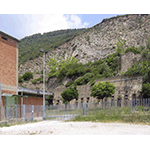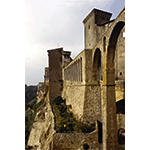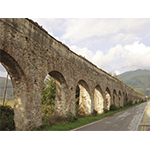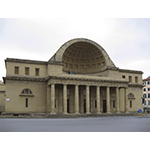Historic aqueducts in Tuscany

Tuscany is frequently thought of as a great open-air museum, a diffused museum spread out over the territory Among the "objects" of greatest interest under the historical-technological profile are undoubtedly its historic aqueducts. They document a problem - that of providing cities with water - which has been a central aspect of urbanised areas for centuries.
Problems of logistics
Building an aqueduct called for good integration of technical capabilities from the engineering and architectural point of view, and scientific competence of the hydro-geological type. It was a question of finding the spring, constructing adequate facilities for drawing and channeling the water, building storage cisterns for decanting it and, frequently, rows of monumental arches to support the overhead channels. At the arrival point, in the vicinity of a city, a complex hydraulic system distributed the water to the main public fountains.
From Pisa to Arezzo, from Livorno to Lucca, almost all of the Tuscan cities have in the countryside around them the imposing arches of historic aqueducts, now integrated into the man-made pattern of the Tuscan landscape.

The most ancient water systems
An itinerary of this kind, if we are to follow a chronological path, must begin with recalling the hydraulic ability of the Etruscans, who seemed to have good knowledge of the technique of ducts excavated in the subsoil and through rocks. A fascinating example is the labyrinth known as that of Porsenna at Chiusi, a dense network of underground passages in the complex drainage system created by the Etruscans in the Archaic period (6th century B.C.) to exploit water from infiltration and from the waterbed.
The aqueduct as an imposing monumental work is an achievement typical of Roman times. With long underground courses realised with special ducts, the Roman aqueducts are associated in the collective imagination with elegant structures rising on arches to overcome obstacles on the ground. Numerous archaeological remains are scattered over the territory governed by ancient Rome, and written works on the subject have also come down to us, among them the De Architectura of Marcus Vitruvius Pollio and the De aquae ductu urbis Romae of Sextus Julius Frontino. In the Tuscan territory, eight great arches have survived in the Caldaccoli locality (from the Latin "calidae aquae", indicating the springs of hot water that gushed out at the foot of the mountain) near San Giuliano. They bear witness to the ancient Roman aqueduct, dating from the last quarter of the 1 st century A.D., which probably supplied water to the baths of Pisa.

Aqueducts built from the Middle Ages to the Renaissance
During the Middle Ages, some of the ancient Roman techniques for building aqueducts were lost. Water for the cities was provided mainly by digging wells, a system that could however cause severe health problems when the water bed was contaminated. However, examples bearing witness to remarkable technical and engineering ability are not lacking.
Particularly surprising is, in fact, the water system constructed in Siena in the Middle Ages and the Renaissance period. These are the "Bottini", a long, intricate complex of tunnels snaking through the subsoil to furnish water to the five public wells and the more than fifty fountains in the city. This project engaged famous Sienese engineers such as Mariano di Iacopo, known as Taccola, and Francesco di Giorgio, who left testimony to the local technological ability in their treatises. Visitors to Siena today can admire the great number of fountains, designed as stupendous architectural structures, decorated by famous artists and all still fed, even today, by the "bottini". The most famous are the Branda Fountain, built in the first half of the 13th century, and the Gaia Fountain in Piazza del Campo, built between 1409 and 1419 by Jacopo della Quercia and fed by the "bottino maestro", enlarged under the direction of Francesco di Giorgio. It is fascinating to visit underground Siena, which retains the traces of the city's various transformations, of the extension of the water pipes, with references to the "contrade", the quarters to which the water was sent, down to the street numbers of the houses.
The chronological itinerary can continue in the Province of Lucca with the fifteenth-century aqueduct of Barga, whose spectacular row of arcades serves as scenographic background to the Parco Fratelli Kennedy [Kennedy Brothers Park], which occupies the medieval town's ancient moat.
Equally fascinating and perhaps even more spectacular is the sixteenth-century aqueduct of Pitigliano, built to the project of Antonio da Sangallo the Younger. Dating from Medicean times are the two great arches supported by an enormous pillar made of blocks of tufa stone, while the remaining thirteen smaller arches date from the subsequent Lorraine period. Three fountains in the adjacent Piazza della Repubblica constitute the terminal of the aqueduct.

The Medicean aqueducts
The aqueducts of Asciano and Arezzo may be considered the two most imposing structures remaining as testimony to the Medicean age.
The Asciano aqueduct was a great work designed to bring water to the city of di Pisa. The project, begun in the late 16th century under the direct orders of Grand Duke Ferdinand I de’ Medici, was completed in 1613 at the time when Cosimo II was Grand Duke. From Monte Pisano the water arrived as far as the city walls, crossing the swampy plain with the ancient system of a duct running above a very long row of arches. Already at the beginning of the 17th century the famous physician Girolamo Mercuriale, in his treatise Dei Bagni di Pisa [Concerning the Baths of Pisa] considered the undertaking one of the "almost divine works of Ferdinand I". In the 18th century Antonio Cocchi, also a learned physician, stated that "the city of Pisa enjoys drinking water that in goodness is second to none in the world, and may even be better than the more famous ones". Today a pedestrian and biking path touches on the aqueduct in many sections.
In Arezzo, at a short distance from the historic centre, can be seen, still in excellent state of conservation, the arches of the Vasari aqueduct built between 1593 and 1603. The public fountain in Piazza Grande was one of the mouths of the aqueduct.

The aqueducts of the Lorraine age
In the 19th century, aqueduct construction resumed at a fast pace, to comply with the need for water linked to the rapid expansion of the cities and the constant, gradual growth of industry. Significant improvements were allowed by the production of new materials and the development of new techniques. With cast iron, larger and stronger ducts could be built, while steam-driven and electric pumps resulted in a notable increase in the quantity and velocity of the water. In the Grand Duchy of Tuscany, the Lorraines pursued a policy of rendering the presence of the State visible through a series of projects of public utility. Falling within this context are the monumental aqueducts. Once again, the classic model of the Roman aqueduct inspired the architects and engineers called upon to build these structures.
Dating from the second half of the 18th century is the aqueduct of Castiglione della Pescaia, designed by Leonardo Ximenes. The work appeared a masterpiece of hydraulic engineering, so much so that, after the piping was replaced in 1816, it continued to function for years. Today it is still possible to admire part of its architectural structure.
One of the most spectacular testimonials of Lorraine times is the aqueduct that brought water to Livorno, known as the Leopoldino. Along its course are found various buildings interesting from the architectural and hydraulic viewpoint. Among these, the most imposing is the neoclassic Cisternino (little cistern) di Pian di Rota, standing in the lovely countryside around Livorno. In the city can be seen the building symbolic of the entire waterworks, known as the Cisternone, or big cistern. An imposing edifice in neoclassic style, it presents on the facade a distinctive cupola cut in half. Another elegant example of neoclassical architecture in the city is the Cisternino, the last of the three great cisterns designed by Pasquale Poccianti. The cistern, which was to receive water from the Colognole Aqueduct and then to feed the city's fountains, through a system of ducts and tunnels, was never put to use. Lastly, a curiosity: the events connected to the building of Livorno's water system are celebrated in a bas-relief at the base of the statue erected in honour of Grand Duke Ferdinand III of Lorraine in Piazza della Repubblica.
As had happened at Livorno, at Grosseto as well a great cistern was built in the first half of the 19th century, which in this case drew in water from a deep water table. In 1846, to make room for a monument dedicated to Grand Duke Leopold II of Lorraine, the parts of the tempietto that crowned it were disassembled and reassembled at Arcidosso.
In the Duchy of Lucca we can admire the aqueduct, almost a mirror image of the Leopoldino at Livorno, built in the 19th century by Lorenzo Nottolini to supply Lucca with water of good quality. The foundations, built from 1825 to 1840, are still amply visible today in the area around the Monumental Aqueduct of Guamo at the foot of Monti Pisani. At Guamo is an elegant neoclassical tempietto-cistern from which departs a long row of arches running through the countryside around Lucca for over three kilometers. Its course can be followed along an enchanting pedestrians' path. At the end of the row of arches, now in the city, stands the tempietto-cistern of San Concordio, a graceful building with circular plan, also in neoclassic style. A number of fountains embellishing the urban center complete the water system of the aqueduct.
-
 Aqueduct of Castiglione della Pescaia
Aqueduct of Castiglione della Pescaia -
 Cisternino di Livorno [Little Cistern of Livorno]
Cisternino di Livorno [Little Cistern of Livorno] -
 Cisternino di Pian di Rota [Little Cistern of Pian di Rota]
Cisternino di Pian di Rota [Little Cistern of Pian di Rota] -
 Cisternone di Grosseto [Large Cistern in Piazza Dante]
Cisternone di Grosseto [Large Cistern in Piazza Dante] -
 Cisternone di Livorno [Large Cistern of Livorno]
Cisternone di Livorno [Large Cistern of Livorno] -
 Fonte del Poggiolo [Poggiolo Spring]
Fonte del Poggiolo [Poggiolo Spring] -
 Leopoldino Aqueduct
Leopoldino Aqueduct -
 Nottolini Aqueduct
Nottolini Aqueduct -
 Leonardo Ximenes
Leonardo Ximenes
****************************
Texts by Graziano Magrini
English translation by Catherine Frost
Last update 05/mar/2008


